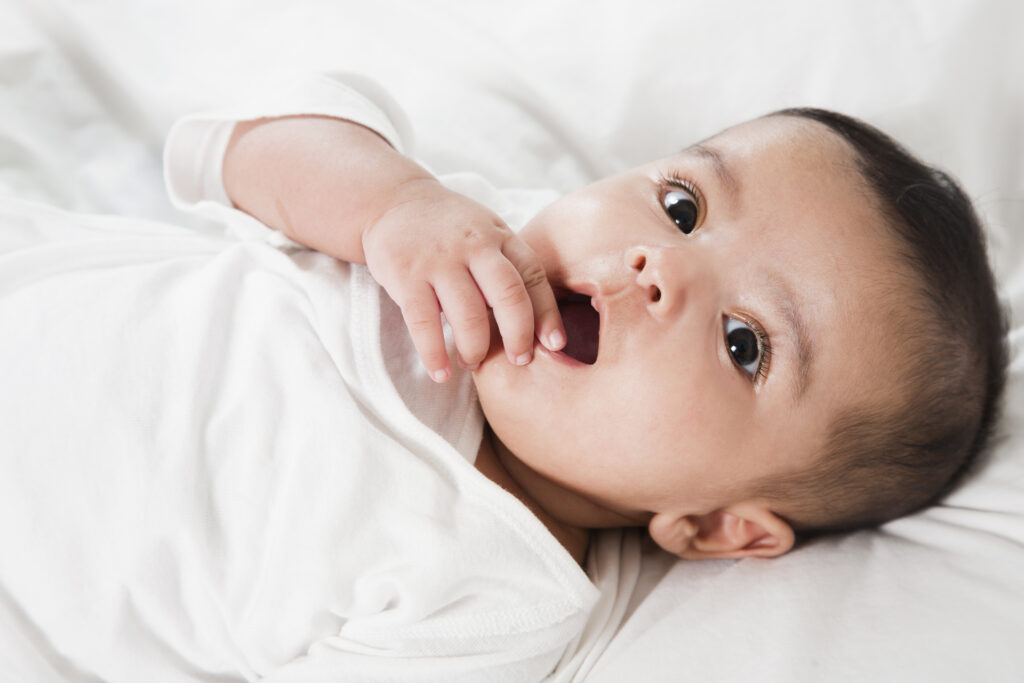Eruption Cysts in Children

You’re expecting your child to get a new tooth soon. But when you look in your child’s mouth, instead of an emerging new tooth, you see…a bluish lump in its place? This can sometimes be a disconcerting experience for parents, but it is not necessarily cause for concern. That bluish lump might be a harmless eruption cyst.
In this article, we will cover the following topics:
- What Is an Eruption Cyst?
- What Causes Eruption Cysts?
- How Are Eruption Cysts Treated?
- What Happens When an Eruption Cyst Bursts?
What Is an Eruption Cyst?
An eruption cyst – sometimes also referred to as an eruption hematoma – is a fluid-filled sac that forms in the gum tissue above a tooth shortly before that tooth erupts (i.e. breaks through the gums). Eruption cysts are typically either translucent or bluish-colored, with the color depending on whether they are filled with a clear cystic fluid, blood or both. (Technically, if the lesion is filled with blood, it is an eruption hematoma, but the terms “eruption cyst” and “eruption hematoma” are often used interchangeably, and the two conditions are treated in the same way.)
Eruption cysts can form over any erupting tooth, including both primary (“baby”) and permanent teeth. They are believed to be relatively uncommon, although their true prevalence is unknown; it is thought that many eruption cysts disappear on their own without ever being diagnosed.
What Causes Eruption Cysts?
An eruption cyst forms when fluid accumulates between the crown of an erupting tooth (i.e., the part of the tooth that will be visible once the tooth erupts through the gums) and the surrounding dental follicle (i.e., the special tissue that surrounds a developing tooth). Although there are various theories as to why this might happen, no one really knows what causes these fluids to accumulate.
How Are Eruption Cysts Treated?
In most cases, eruption cysts rupture on their own and do not require any treatment. In certain cases, if eruption of the underlying tooth appears to be delayed, a dentist may cut the cyst open to help the tooth erupt.
What Happens When an Eruption Cyst Bursts?
When the eruption cyst bursts, the cystic fluid and/or blood inside will drain out. Typically, the underlying tooth will then erupt and no treatment will be necessary.
Pediatric Dentistry in Hurst, TX
If you notice a lump in your child’s gums, do not panic – it may be a completely benign condition like an eruption cyst. However, it’s always a good idea to take your child to the dentist to have the lump examined just in case, especially if the lump persists for more than a few weeks.
Hurst Pediatric Dentistry’s Dr. Lin is a board-certified pediatric dentist who has experience with eruption cysts and other types of oral cysts. To make an appointment, call us at 817-510-6400 or request an appointment online.
Hurst Pediatric Dentistry is located in Hurst, Texas, and treats pediatric patients from Hurst, Euless, Bedford, North Richland Hills, Colleyville, Keller, Southlake, Irving, and the surrounding area.
This article is intended to provide general information about oral health topics. It should not be used to diagnose or treat any medical condition or as a substitute for the advice of a healthcare professional who is fully aware of and familiar with the specifics of your case. Always seek the advice of your dentist or other qualified healthcare provider with regard to any questions you may have relating to a medical condition or treatment.
MEDICALLY REVIEWED BY:
Dr. Jin Lin

Dr. Jin Lin is a board-certified pediatric dentist with a passion for helping children achieve healthier, more beautiful smiles. He earned his Bachelor of Science degree from Cornell University and his Doctor of Dental Medicine (D.M.D.) degree from the Harvard School of Dental Medicine. After graduating cum laude from dental school, he completed his post-doctoral pediatric dentistry training at Boston Children’s Hospital and the Harvard School of Dental Medicine, where he served as chief resident and worked with children with a wide variety of special medical and dental needs, including children with rare syndromes.

